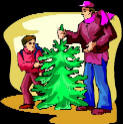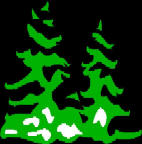Christmas and Christmas Tree Facts
Obscure Christmas tree facts to amaze your friends!
Christmas Tree History
-
The use of evergreen trees to celebrate the winter season occurred before the
birth of Christ.
-
The first decorated Christmas was in Riga, Latvia in 1510.
-
The first printed reference to Christmas trees appeared in Germany in 1531.
-
Nineteenth century Americans cut their trees in nearby forests.
- Christmas trees have been sold commercially in the United
states since about 1850. Until fairly recently, all Christmas trees came
from the forest.
-
The first Christmas tree retail lot in the United States was started in 1851
in New York by Mark Carr.
-
In 1900, large stores started to erect big illuminated Christmas trees.
Christmas trees and the environment
-
Growing Christmas trees provides a habitat for wildlife.
-
Recycled trees have been used to make sand and soil erosion barriers and been
placed in ponds for fish shelter.
-
Christmas trees remove dust and pollen from the air.
-
Artificial trees will last for six years in your home, but for centuries in a
landfill.
-
59 percent of real Christmas trees harvested are recycled in community
programs.
-
An acre of Christmas trees provides for the daily oxygen requirements of 18
people.
Artificial / Fake Trees
-
In 2002, 21% of United States households had a real
tree, 48% had an artificial tree and 32% had no tree.
-
Most fake (artificial) trees (85%) in the U.S. are imported from
China. Almost 10 Million fake trees were sold worldwide in 2003. The U.S.
Commerce Dept. tracks the
Import of Fake Trees
-
Real Christmas trees are involved in less than one-tenth of one percent of
residential fires and only when ignited by some external ignition sources.
Christmas Tree Numbers
-
Thirty-four to thirty-six million Christmas trees are produced
each year and 95 percent are shipped or sold directly from Christmas tree farms.
-
28 million Christmas trees were sold in 2001.
-
More than one million acres of land have been planted in
Christmas trees. The industry employs over 100,000 people. Many Christmas tree
growers grow trees on a part-time basis to supplement farm and non-farm income.
-
More than 2,000 trees are usually planted per acre. On an
average 1,000-1,500 of these trees will survive. In the North, maybe, 750 trees
will remain. Almost all trees require shearing to attain the Christmas tree
shape. At six to seven feet, trees are ready for harvest. It fighting heavy
rain, wind, hail, pests and drought to get a mature tree.
-
Christmas trees take an average of 7-10 years to
mature.
-
100,000 people are employed in the Christmas tree industry.
-
98 percent of all Christmas trees are grown on farms.
Origin: from where do they come?
-
California, Oregon, Michigan, Washington, Wisconsin,
Pennsylvania and North Carolina are the top Christmas tree producing states.
-
Oregon is the leading producer of Christmas trees - 8.6 million in 1998
and in 2001, 8.3 million trees were
harvested in Oregon.
-
The top six Christmas tree producing states Oregon, North Carolina,
Pennsylvania, Michigan, Washington & Wisconsin.
Christmas Tree Varieties / Types
-
The best selling trees are Scots Pine, Douglas fir, Noble fir,
Fraser fir, Virginia pine, Balsam fir and white pine.
-
Other types of trees such as cherry and hawthorns were used as Christmas trees
in the past.
Christmas Tree Farms and Farming
-
Christmas trees are grown in all 50 states including Hawaii and Alaska.
-
Selling directly to the consumer has become a major market for
many Christmas tree farms. Some tree farms offer the consumer the chance to
select his own tree while it is still growing in the tree farm.
-
82% of Christmas trees purchased
were pre-cut and 18% were cut your own.
-
In North America, there are more than 15,000 Christmas tree
growers.
-
In the United States, there are more than 12,000 cut-your-own
farms.
-
More than 1,000,000 acres of land have been planted to Christmas trees.
-
On average, over 2,000 Christmas trees are planted per acre.
-
73 million new Christmas trees will be planted this year.
-
There are over 500 Christmas tree growers in Illinois.
-
Michigan ranks fourth (4 million trees in 1998) among all states in the
production of real Christmas trees, but grows a larger variety (13) of Christmas
trees than any other state.
-
2-3 seedlings are planted for every harvested Christmas tree.
-
Helicopters sometimes help to lift harvested Christmas trees from farms.
Public Christmas trees
-
Since 1971, the Province of Nova Scotia has presented the Boston Christmas
Tree tree to the people of Boston in gratitude for the relief supplies received
from the citizens of Boston after a ship exploded in 1917 following a collision
in the Halifax, Nova Scotia Harbor. Part of the city was leveled killing and
injuring thousands.
The US National Christmas Tree and Christmas Trees in the White House
-
In 1856 Franklin Pierce, the 14th President of the United States, was the
first President to place a Christmas tree in the White House.
-
President Coolidge started the National Christmas Tree Lighting Ceremony on
the White House lawn in 1923.
-
Teddy Roosevelt banned the Christmas tree from the White House for
environmental reasons.
-
In 1963, the National Christmas Tree was not lighted until December 22nd
because of a national 30-day period of mourning following the assassination of
President Kennedy.
-
Since 1966, the National Christmas Tree Association has given a Christmas tree
to the President and first family.
-
In 1979, the National Christmas Tree was not lighted except for
the top ornament? This was done in honor of the American hostages in Iran.
-
In 1984, the National Christmas was lit on December 13th with temperatures in
the 70's, making it one of the warmest tree lightings in history.
Odd Christmas Tree Facts
-
Between 1887-1933 a fishing schooner called the "Christmas Ship"
would tie up at the Clark Street bridge and sell spruce trees from Michigan to
Chicagoans.
Christmas Trees on the Internet
-
More than 330,000 real Christmas trees are sold via e-commerce or catalogs.
Christmas tree safety
-
You should never burn your Christmas tree in the fireplace. it can contribute
to creosote buildup.
-
In the first week, a tree in your home will consume as much as a quart of
water per day.
Christmas tree lights and ornaments
-
Using small candles to light a Christmas tree dates back to the middle of the
17th century.
-
Thomas Edison's assistant, Edward Johnson, came up with the idea of electric
lights for Christmas trees in 1882.
-
Christmas tree lights were first mass produced in 1890.
-
A Christmas tree decoration was banned by the government. Tinsel contained
lead at one time, now it's made of plastic.
Christmas tree economics and marketing
-
In 2002, 21% of Christmas trees sold were from chain stores;
16% by non-profit groups; 22% from retail lots and 35% from choose and cut
farms.
-
The value of all Christmas trees harvested in 2001 was $360 million.
-
Christmas trees are baled to protect the branches from damage during shipping.
-
34-36 million Christmas trees were harvested in the United States in 2001.
-
Every year since 1947, the people of Oslo, Norway have given a Christmas tree
to the city of Westminster, England. The gift is an expression of good will and
gratitude for Britain's help to Norway during World War II.
-
日韩精品久久无码中文字幕|
亚洲国产精品无码久久一线|
人妻丰满熟妇AV无码片|
99久久无色码中文字幕|
国产成人无码久久久精品一|
中文字幕乱人伦|
精品久久久久久中文字幕大豆网
|
日韩精品无码久久久久久
|
中文字幕色婷婷在线视频|
亚洲av无码国产精品夜色午夜
|
中文字幕在线精品视频入口一区|
亚洲av无码片在线播放|
在线中文字幕一区|
久久精品无码一区二区三区日韩|
在线a亚洲v天堂网2019无码|
亚洲制服中文字幕第一区|
亚洲精品无码成人片在线观看
|
在线看无码的免费网站|
亚洲av日韩av高潮潮喷无码|
中文字幕毛片|
日本不卡中文字幕|
中文 在线 日韩 亚洲 欧美|
久久无码精品一区二区三区|
国产精品ⅴ无码大片在线看|
亚洲av中文无码乱人伦在线r▽
|
国产精品 中文字幕 亚洲 欧美|
国产成年无码久久久久毛片|
无码精品国产VA在线观看DVD
|
国内精品人妻无码久久久影院导航|
99高清中文字幕在线|
人妻精品久久久久中文字幕69|
制服丝袜中文字幕在线|
亚洲熟妇中文字幕五十中出|
最近免费中文字幕MV在线视频3
|
亚洲精品一级无码中文字幕|
久久99久久无码毛片一区二区
|
亚洲免费无码在线|
亚洲成?v人片天堂网无码|
国产亚洲精品无码拍拍拍色欲|
国产产无码乱码精品久久鸭|
2024你懂的网站无码内射|
 Christmas Tree
Farms, Tree Lots, Hayrides, Sleigh Rides and Other Winter Fun
Christmas Tree
Farms, Tree Lots, Hayrides, Sleigh Rides and Other Winter Fun